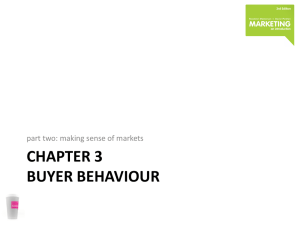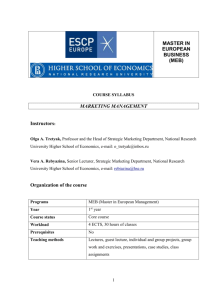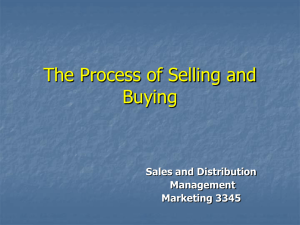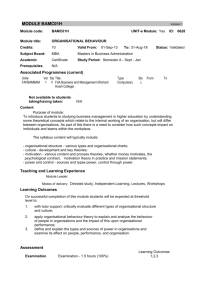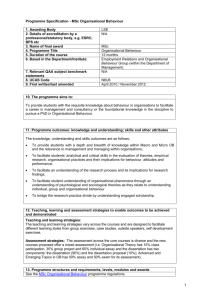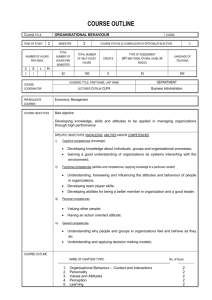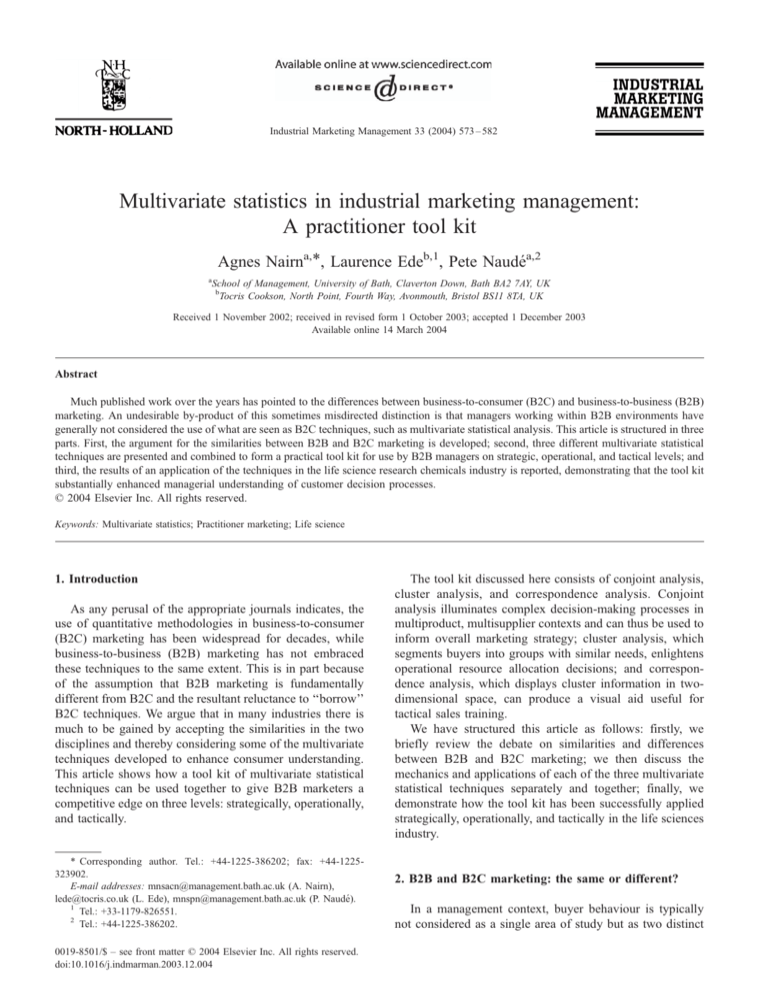
Industrial Marketing Management 33 (2004) 573 – 582
Multivariate statistics in industrial marketing management:
A practitioner tool kit
Agnes Nairna,*, Laurence Edeb,1, Pete Naudéa,2
a
School of Management, University of Bath, Claverton Down, Bath BA2 7AY, UK
b
Tocris Cookson, North Point, Fourth Way, Avonmouth, Bristol BS11 8TA, UK
Received 1 November 2002; received in revised form 1 October 2003; accepted 1 December 2003
Available online 14 March 2004
Abstract
Much published work over the years has pointed to the differences between business-to-consumer (B2C) and business-to-business (B2B)
marketing. An undesirable by-product of this sometimes misdirected distinction is that managers working within B2B environments have
generally not considered the use of what are seen as B2C techniques, such as multivariate statistical analysis. This article is structured in three
parts. First, the argument for the similarities between B2B and B2C marketing is developed; second, three different multivariate statistical
techniques are presented and combined to form a practical tool kit for use by B2B managers on strategic, operational, and tactical levels; and
third, the results of an application of the techniques in the life science research chemicals industry is reported, demonstrating that the tool kit
substantially enhanced managerial understanding of customer decision processes.
D 2004 Elsevier Inc. All rights reserved.
Keywords: Multivariate statistics; Practitioner marketing; Life science
1. Introduction
As any perusal of the appropriate journals indicates, the
use of quantitative methodologies in business-to-consumer
(B2C) marketing has been widespread for decades, while
business-to-business (B2B) marketing has not embraced
these techniques to the same extent. This is in part because
of the assumption that B2B marketing is fundamentally
different from B2C and the resultant reluctance to ‘‘borrow’’
B2C techniques. We argue that in many industries there is
much to be gained by accepting the similarities in the two
disciplines and thereby considering some of the multivariate
techniques developed to enhance consumer understanding.
This article shows how a tool kit of multivariate statistical
techniques can be used together to give B2B marketers a
competitive edge on three levels: strategically, operationally,
and tactically.
* Corresponding author. Tel.: +44-1225-386202; fax: +44-1225323902.
E-mail addresses: mnsacn@management.bath.ac.uk (A. Nairn),
lede@tocris.co.uk (L. Ede), mnspn@management.bath.ac.uk (P. Naudé).
1
Tel.: +33-1179-826551.
2
Tel.: +44-1225-386202.
0019-8501/$ – see front matter D 2004 Elsevier Inc. All rights reserved.
doi:10.1016/j.indmarman.2003.12.004
The tool kit discussed here consists of conjoint analysis,
cluster analysis, and correspondence analysis. Conjoint
analysis illuminates complex decision-making processes in
multiproduct, multisupplier contexts and can thus be used to
inform overall marketing strategy; cluster analysis, which
segments buyers into groups with similar needs, enlightens
operational resource allocation decisions; and correspondence analysis, which displays cluster information in twodimensional space, can produce a visual aid useful for
tactical sales training.
We have structured this article as follows: firstly, we
briefly review the debate on similarities and differences
between B2B and B2C marketing; we then discuss the
mechanics and applications of each of the three multivariate
statistical techniques separately and together; finally, we
demonstrate how the tool kit has been successfully applied
strategically, operationally, and tactically in the life sciences
industry.
2. B2B and B2C marketing: the same or different?
In a management context, buyer behaviour is typically
not considered as a single area of study but as two distinct
574
A. Nairn et al. / Industrial Marketing Management 33 (2004) 573–582
subsets, consumer buyer behaviour and organisational buyer
behaviour (Fern & Brown, 1984). This distinction results
from the perceived differences between consumer and
industrial markets suggested by many textbooks (Kotler,
2003; Wilson, 2000).
The fact that the differences have been promulgated for
over a quarter of a century has almost certainly had an
impact on the lack of inclination to use statistical techniques
in organisational marketing. Three factors may have contributed to this phenomenon. First, many statistical techniques and principles are based on the central limit theorem,
whereby many sampling units are all assumed to be of equal
importance. With many B2B markets typically composed of
a few buyers varying radically in their importance to the
seller, it is easy to see why the relevance of statistics might
not be immediately apparent. Second, if the relationship
between organisational buyer and seller is assumed to be
close—even personal—then the significance of impersonal
mathematical aids is not obvious. Third, if the buying
process in organisations is influenced by several parties,
and if at least some of these are trained professionals, then
the application of tools designed to understand individual
decision-making psychology may seem quite inappropriate.
However, several writers have questioned the validity of
the B2B – B2C distinction. Shaw, Giglierano, and Kallis
(1989), for instance, observe that organisational buyers
and consumers are in fact the same set of people only in
different buying situations. They go on to ask, ‘‘Are we to
believe that an executive makes business buying decisions
based on quantifiable product characteristics and yet makes
personal buying decisions based on intangibles?’’ (p. 45).
Wilson (2000) poses the question, ‘‘Why should we assume
that separate theories are necessary to explain the exchange
behaviour adopted by the same individual when placed in
different contexts?’’ (pp. 780 – 781), concluding that ‘‘it is
debatable whether or not the surviving differences between
organizational and consumer marketing constitute a sufficient or worthwhile basis for continuing a distinction at a
theoretical level’’ (pp. 794). Concurring views are advanced
by Foxall (1981), who writes ‘‘Industrial buying behaviour
differs from that of final consumers not so much in kind as
in degree. The stages, which comprise the respective decision sequences, are broadly similar’’ (pp. 135), and by
Brown (1984), who contends that ‘‘practical experience
and considerable research tell us that many of the individual/subjective influences [that shape consumer buyer behaviour] are also evident in organizational purchasing
situations’’ (pp. 12). Furthermore, these views are not
restricted to a belief that consumer and organisational
buying are broadly similar but that specific elements of
consumer and organisational buyer behaviour are also
comparable. For example, Shipley and Howard (1993)
consider only one aspect of organisational buyer behaviour,
the impact of branding, but conclude that its application in
the contexts of consumer and organisational buying behaviour is similar.
The central thesis underlying these views is that the two
concepts of consumer and organisational buyer behaviour
represent ‘‘extreme examples’’ rather than normative, generalisable models, which ‘‘although they do exist, tend to
obscure the more basic similarities between industrial and
consumer marketing’’ (Fern & Brown, 1984). We propose,
in agreement with Fern and Brown, that buyer behaviour be
viewed not in terms of these two extremes but rather as a
continuum against which any of the theories of buyer
behaviour may be more or less applicable.
3. When can multivariate statistics be applied?
If we accept that organisational buying behaviour is
different from consumer buying behaviour in degree rather
in form, then it is important to ascertain in which organisational buying contexts it is appropriate to use multivariate
statistics that have ostensibly been designed to measure
facets of individual decision making. Sheth (1973) provides
a useful framework in his assertion that ‘‘organizational
buyer behaviour consists of three distinct aspects. The first
aspect is the psychological world of the individuals involved
in organizational buying decisions. The second aspect
relates to the conditions that precipitate joint decisions
among these individuals. The final aspect is the process of
joint decision making with the inevitable conflict among the
decision makers and its resolution by resorting to a variety
of tactics’’ (pp. 52). Much of the industrial marketing
literature is devoted to the second two aspects of Sheth’s
framework (e.g., Choffray & Lilien, 1980; Morris, Berthon,
& Pitt, 1999; Pettigrew, 1975). While multivariate techniques have occasionally been used to enlighten such contexts
(e.g., Lockett & Naudé, 1991), it is an understanding of the
first of Sheth’s aspects (i.e., ‘‘the psychological world of the
individuals involved in organisational buying decisions,’’)
which can be enhanced by the statistical tool kit discussed in
this article. The introduction of such tools into the industrial
marketing literature may encourage a new stream of research into the process of individual decision making within
the firm—an area that has been somewhat neglected,
perhaps for want of suitable techniques.
Another model, which may aid managerial decisions as
to the appropriate contexts for using statistical techniques, is
the buygrid model developed by Robinson, Faris, and Wind
(1967). They argue that organisational buyer behaviour
varies according to the buying situation, which may be
classed as ‘‘new task,’’ ‘‘modified rebuy,’’ or ‘‘straight
rebuy’’. It is more likely that decision making at the new
task stage will encompass Sheth’s joint decision making and
conflict resolution contexts as more risk is involved, while
the straight rebuy stage is most likely to comprise individual
decision making. Most buying tasks fall into this latter
category, but more effort is expended on understanding
the more complex intricacies of coalition decision making
on new and therefore more highly involving purchase


